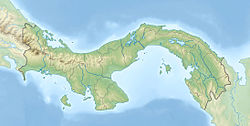| Culebra Formation | |
|---|---|
| Stratigraphic range: Aquitanian-Burdigalian (Late Arikareean-Hemingfordian) | |
| Type | Formation |
| Sub-units | Emperador Limestone |
| Underlies | Cucaracha Formation |
| Overlies | Las Cascadas Formation |
| Thickness | > 250 m (820 ft) |
| Lithology | |
| Primary | Sandstone, limestone, mudstone, shale |
| Other | Siltstone, conglomerate, lignite |
| Location | |
| Coordinates | 9°06′N79°42′W / 9.1°N 79.7°W |
| Approximate paleocoordinates | 8°24′N77°30′W / 8.4°N 77.5°W |
| Region | Colón Province |
| Country | Panama |
| Extent | Panama Basin |
| Type section | |
| Named for | Culebra Cut |
The Culebra Formation (Tcb) [1] is a geologic formation in Panama. It preserves fossils dating back to the Miocene period; Early Miocene epoch, Aquitanian to Burdigalian stages (Late Arikareean to Hemingfordian in the NALMA classification). [2] Fossils of Culebrasuchus have been found in and named after the formation. [3] The thickness of the formation is at least 250 metres (820 ft) thick, [4] and the age has been estimated as from 23 to 19 Ma. [5]
